
Modernization
Learn more about government’s intention to modernize the museum to protect our historic holdings and provide better access to our collections.
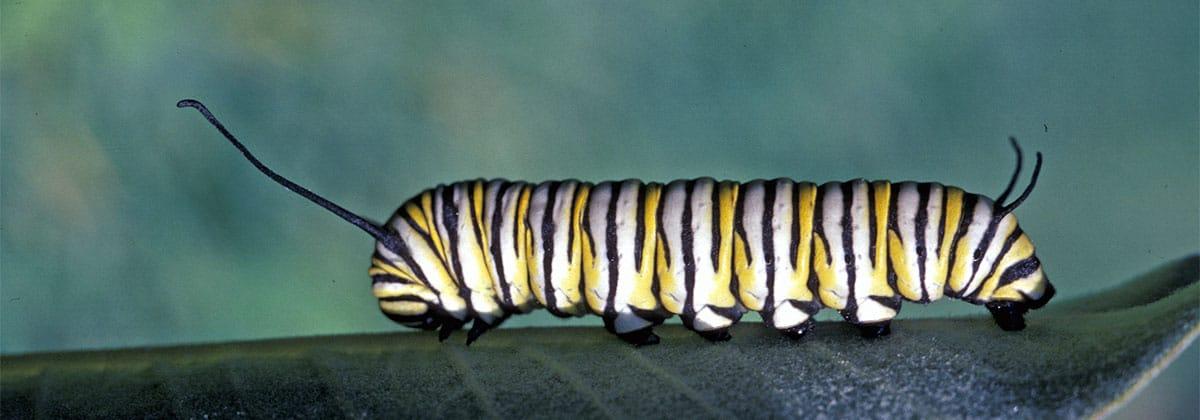
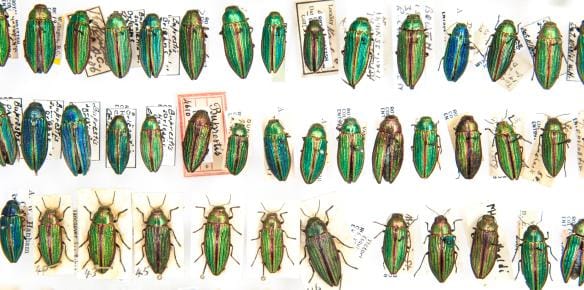
Research collections underpin the scientific study of insects and other terrestrial arthropods. These collections are the record of the natural diversity, and therefore of the natural heritage, of a region. The tremendous diversity of insects and their relatives is largely unappreciated, and so is the elementary state of our scientific knowledge of them. Insects and other terrestrial arthropods, despite their small size, are the dominant animals in terrestrial and freshwater ecosystems. They make up at least 75% of the more than 1 million species recorded on earth. Because estimates of the real number of living kinds of these organisms varies from about 3 to 30 million, much basic work, including collections development, must still be undertaken.
General entomological collections, especially those that take large geographical areas as their scope, are always works in progress. Insects and their terrestrial arthropod relatives are so diverse, so hard to collect comprehensively, and often so difficult (or impossible) to identify, that significant gaps in taxonomic, life-history, geographical and ecological coverage in collections are commonplace and taken for granted by biologists who understand the problems. It is hard to conceive that we know so little about most of the organisms with which we share the earth, but this is the world we live in. Even many biologists do not comprehend that there are few lists of, or good identification resources to, most insect species. The incompleteness of terrestrial arthropod collections is typical, even in collections with many scientific staff specializing on many different orders and families. Thus, plans for collections growth assume that true comprehensiveness and completeness (even if this could ever be defined) will never be achieved, at least not for hundreds of years.
Specimens in a museum entomology research collection are assembled over many years by a succession of collectors, curators, and collection managers who, to some extent, understand the characteristics of the regional fauna and landscape. The specimens must be carefully prepared and preserved, labeled with field data, sorted and safely stored. Ideally, data are organized electronically so that information on specimens can be accessed and distributed efficiently. These specimens and their data thus become available, and progressively more valuable, for scientific study, as time passes. Without this accumulation over many years, species previously unrecognized or little known would never become defined and identifiable entities, and much of our knowledge of their ranges, habitats and ecological significance would never be assembled. Indeed, as environments are modified, collections provide indispensable benchmarks for documenting changing plant and animal communities. Well-maintained collections of terrestrial arthropods are irreplaceable sources of scientific information about our past and present, and will help guide future decisions and research.
Identification is the key that unlocks the information available on any species. When specimens documented with field data are identified by an expert on that group, they become reference points for research detailing the taxonomy, biogeography and biology of particular species. These specimens also become references for identifying other specimens submitted from sources in agriculture, forestry, education, public health, environmental studies, or the general public. Unfortunately, identification of large amounts of material from a range of groups present in collections may take many decades. Many groups of insects and other terrestrial arthropods have no experts working on them and species identification is impossible. Some groups are in such poor shape taxonomically that even experts cannot make detailed determinations. When experts for particular taxa do exist, they are often overwhelmed with identification requests and cannot help. Nevertheless, we frequently loan material to experts who can help and, periodically, visiting researchers identify some of our specimens. We collect material in the expectation that particular identification expertise will be available, if not at present, then sometime in the future.
In the entomology collection, we amass specimens for present research and future, as yet unknown, uses. We accept donations of specimens that meet our requirements, for we know that such valuable material might otherwise be lost to science. We collect assiduously, despite the restrictions of having few staff, limited resources and little available time. Although we gather specimens from all orders from all over BC, and often from regions outside the province (because organisms do not organize themselves according to political boundaries and the regional and world context of BC material is critical to its interpretation), in different years we may focus on particular groups and localities in order to fill gaps in the collection. We might stress work in areas seldom visited in order to build collections from poorly known environments; we often concentrate on collecting groups of organisms for which we have few specimens, so as to redress imbalances in the collection. As much as possible, we work in the field with other agencies whose goals are similar to ours; shared logistics, finances, and results are mutually beneficial.
Description
The research collection database contains 243,903 specimens/lots. This consists of 191,096 pinned specimens, 35,159 in envelopes (predominantly Odonata [dragonflies], but also some Lepidoptera [butterflies]) and 14,823 specimens or lots of material in vials or jars of 70% ethanol (especially Araneae [spiders] and Odonata larvae). There are a few lots of material in 95% ethanol for use in molecular analyses. The microscope slide collection is tiny—only 174 slides. Much of the collection is not accessioned or databased. This material probably represents an additional 150,000 specimens.
Different insect life stages are represented, immatures being particularly common in the ethanol collection where specimens that tend to shrivel when dried are stored. Spiders (adults) and immature and adult aquatic insects (especially Ephemeroptera, Plecoptera, Trichoptera and immature Odonata) are mainstays of the ethanol collection. For example, there are 3318 specimens or lots of accessioned Odonata larvae, most in ethanol, representing about 10% of the dragonfly collection.
The type specimen collection is small and predominantly consists of paratypes. The following numbers are of species and subspecies only, not numbers of specimens. Holotypes: Coleoptera (species – 1), Lepidoptera (subspecies – 7), Mecoptera (species – 1). Paratypes: Coleoptera (species – 10, subspecies – 5), Hemiptera (species – 11), Diptera (species – 13), Hymenoptera (species – 4, subspecies – 3), Lepidoptera (species – 11, subspecies – 11), Mecoptera (species – 1), Odonata (species – 9). Types and Cotypes: Coeoptera (species – 1), Lepidoptera (species – 3).
The earliest collections were assembled in 1886. In the early 1900s donations from members of the Entomological Society of BC formed the collection’s nucleus. But it was not until the early 1970s that the haphazardly stored collections were amalgamated and organized into standard insect cabinets. Since then, a significant effort has been made to improve and standardize cabinets, drawers, unit trays, vials and labeling methods. Collection dates range from the 1880s to the present. The main collectors represented in the collection, in order of the number of accessioned specimens collected are: Robert Cannings (16,705), Crispin Guppy (12,631), George Hardy (7622), Gordon Hutchings (7145), David Blades (5689), Harold Foxlee (5472), Sydney Cannings (5165), Gerald Straley (4547), Jon Shepard (4359) and Abdiel Hanham (3572).
The collection, including the type collection, continues to grow through active collecting by staff and research associates (general collecting, targeted research collecting), by donations from scientists and other collections, and through donations from the public (identification requests, personal collections). Most specimens are from BC localities: 111,736 specimens of 141,743 with localities databased are from the province—almost 80% of the total. In some groups, active research has resulted in the accumulation of significant material from around the world (e.g., Odonata, Lepidoptera, Diptera: Asilidae).
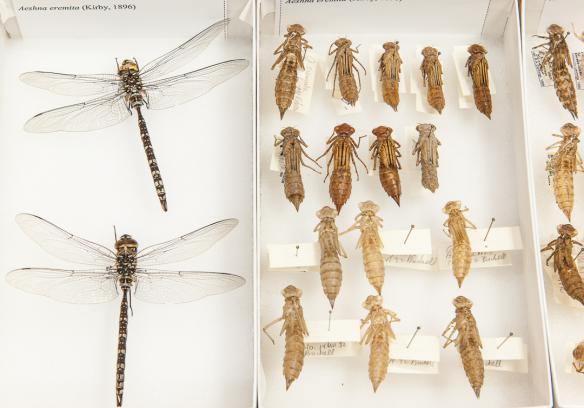
Taxonomic strengths
Strengths include adult Odonata (dragonflies), macro-Lepidoptera (butterflies and large moths), Vespidae (yellowjacket and related wasps), Apidae (especially bumble bees), some Coleoptera (beetles—especially Carabidae and Cerambycidae), Hemiptera (at least Heteroptera—true bugs), Orthoptera (grasshoppers and crickets), some Diptera (true flies—at least Asilidae) and Araneae (spiders).
The following short list gives those orders represented by more than 400 accessioned specimens. Large orders that contain families having more than 2,000 specimens in the collection have those families and their numbers included. Neuroptera (412); Trichoptera (447); Orthoptera (2,787); Homoptera (3,761); Araneae (4,276); Hemiptera (7,753); Hymenoptera (25,605: Formicidae [4,500]); Diptera (35,373: Tachinidae [2,262], Syrphidae [2,672], Asilidae [5242]); Odonata (38,309: Lestidae [3,586], Corduliidae [3,771], Aeshnidae [8,570], Libellulidae [10,069], Coenagrionidae [10,387]); Coleoptera (57,864: Scarabaeidae [2,248], Buprestidae [2,316], Curculionidae [2,544], Coccinellidae [2,670], Staphylinidae [2,702], Chrysomelidae [3,072], Elateridae [4,021], Cerambycidae [8,577], Carabidae [9,183]); Lepidoptera (61,165: Pieridae [2,503], Hesperiidae [3,131], Lycaenidae [4,502], Nymphalidae [4,780], Geometridae [14,008], Noctuidae [20,207]).
Geographical strengths
Generally, the RBCM entomology collection is a collection of BC material. As noted above, approximately 80% of the specimens with databased locality information are from the province.
The most important geographical issue for the collection is the strength of representation of a species or other taxon within BC. This remains unanalyzed, although for some groups, relatively accurate statements can be made. For example, the Odonata are well collected over much of the province, thanks to significant surveys from 1996-2006 that added many records to an already good collection. These surveys produced about 21,000 specimens from over 1,580 localities. In addition, the collections included 85 of 87 known BC species, found five species new to the province, and documented many range extensions and changes in species status. Coverage for the Odonata is not uniform or complete, but is much better than for most other orders. Numbers of records and collection sites (to 2004) are mapped per topographical grid (1:50,000 map sheets) for each species. Non-BC families, genera and species from around the world are also represented in the Odonata collection. The butterfly part of the Lepidoptera collection is also rather well represented geographically in BC.
Management/documentation strengths of the collection (e.g., identification, labeling, databasing):
Most adult Odonata (dragonflies), Macrolepidoptera (butterflies and large moths), Vespidae (yellowjacket and related wasps), Apidae (especially bumblebees), pinned Orthoptera (grasshoppers and crickets), and Araneae (spiders) are identified to species and well-curated (databased, labeled, and stored in such a way that they can be located quickly).
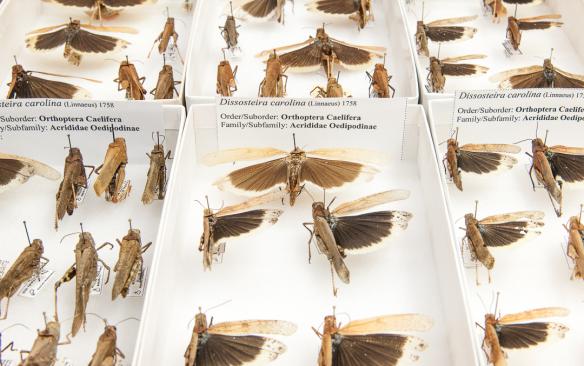
Taxonomic Gaps
In general, groups mainly consisting of small or fragile specimens, many of which are difficult to find or which take specialized collecting or preparation techniques, are poorly represented in the Royal BC Museum’s entomology collection. These include:
Priorities also include species on which specific research projects are focused (such as the Asilidae and Araneae) and species in groups listed above as being poorly represented in the collection.
Geographical Gaps
Most groups are poorly represented geographically, although this problem has not been analysed in detail. As might be expected, collections of most groups have a strong bias towards the southern lowlands where most collecting has occurred and species diversity is highest (southern Vancouver Island, Lower Mainland, Thompson-Okanagan). This is less a problem in southern groups such as robber flies (Diptera: Asilidae) where diversity is predominantly in the southern grasslands and forests and much of the province is species-poor.
Species that are endemic to BC or that range mostly in BC are always prioritized because we have a responsibility to study and manage these species. We also target species that illustrate important biogeographical histories relevant to BC and regions of the province representing geographical gaps in the collection, or otherwise poorly collected regions, for the collection as a whole or for specific taxa. For example, collections from northern and central British Columbia are high priority because of meagre coverage in most of the collection.
Species that will be at the forefront of change as climate warming continues—freshwater, grassland, tundra, and seashore species—will be prioritized. Rare and endangered species and species occurring in rare habitats or habitats threatened by industrial development (for example, by the oil and gas industry, mining and hydro) and introduced species will also be given priority.
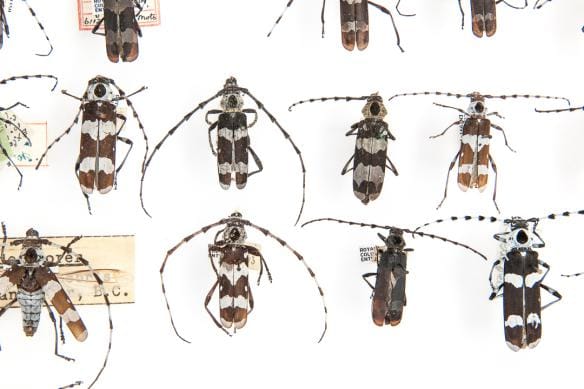
Entomology staff collects every year, to a greater or lesser degree, for both research and collections development purposes. Typically, three or four short trips of a week or less and one or two longer trips of up to two weeks are undertaken to various parts of the province. Priorities for field work are based on the needs of research projects and the requirements of collections development.
Specimens are accepted via donation whenever they are available to improve the collection. They range from a single specimen brought to the museum for identification by a member of the public to a large collection of hundreds of specimens donated by a researcher or by an estate after a private collector has died. Donations may be several dozen specimens of particular species given by an entomological colleague after an external research project has been completed or they may be thousands of specimens amassed during a study comparing several forest habitats. Databased collections with complete collection and identification data are ideal, but uncommon.
Collection priorities
Taxonomic: Priorities include species on which specific research projects are focused (such as the Asilidae and Araneae) and species in groups listed above as being poorly represented in the collection. In 2012, a general collecting trip to the Upper Columbia region also targeted spiders. Collections by various research associates are also significant.
Geographic: Species that are endemic to BC or that range mostly in BC are always prioritized because we have a responsibility to study and manage these species. We also target species that illustrate important biogeographical histories relevant to BC and regions of the province representing geographical gaps in the collection, or otherwise poorly collected regions, for the collection as a whole or for specific taxa. For example, collections from northern and central British Columbia are high priority because of meagre coverage in most of the collection. In the coming years, certain regions, such as the Peace River Valley (the location of the proposed Site C dam) may be developed, potentially resulting in the drastic alteration of ecosystems. Before such activities occur, we plan to collect insects and other arthropods there. In addition, the area of BC lying east of the Rockies has a significantly different fauna from other areas of northern BC and warrants attention for purely biogeographical reasons, even though some groups in the collection (butterflies, dragonflies) are relatively well-collected there.
Ecological: Species that will be at the forefront of change as climate warming continues—freshwater, grassland, tundra, and seashore species—will be prioritized. Rare and endangered species and species occurring in rare habitats or habitats threatened by industrial development (oil and gas industry, mining, hydro) and introduced species will also be given priority.
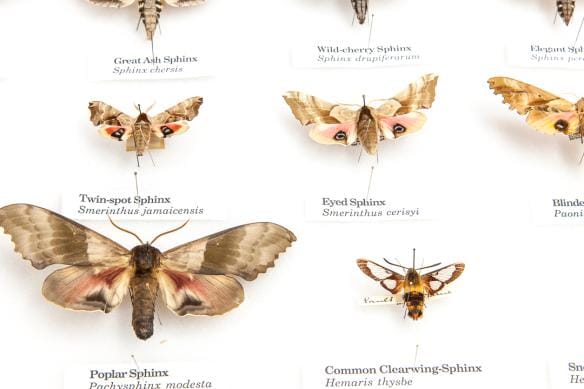
Research Project: Documentation of terrestrial arthropod diversity in British Columbia
Estimates suggest there are about 35,000 species of insects in BC, and thousands of additional species of arachnids (spiders, ticks, mites, and so on) and other terrestrial arthropods, but probably less than half have so far been recorded. This project is designed to document the terrestrial arthropod fauna of the province, emphasizing species that are rare or threatened or that come from threatened habitats (in consultation with the Conservation Data Centre), those that are introduced or invasive, those that are in need of taxonomic clarification (including undescribed species), those that are endemic to BC or have much of their geographical range in BC, those that occur in poorly sampled parts of BC and those that illuminate historical changes in the province’s biogeography. Priority is also given to projects that contribute information to the development of new exhibits in the museum. All parts of this project contribute significant material and information to our collections.
The project clarifies taxonomy, natural history and historical biogeography and publishes annotated species lists, faunistic studies, identification keys, genus revisions and descriptions of new species. Products range from articles in popular magazines to peer-reviewed papers in scientific journals, from technical reports to books of various sorts, from public presentations to internet articles.
Collection emphasis for the coming years will be on conducting a comprehensive survey of the spider fauna of British Columbia, similar to the survey work undertaken for dragonflies in years past. Estimates suggest there are over 1,000 species of spiders (Araneae) in BC; approximately 800 have so far been recorded and many habitats in the province have never been sampled. Our long-term goal is to document the spider fauna of the province: species, distributions, habitat preferences, and phenology. High elevation sites in particular have, to-date, been poorly sampled for all arthropods except Lepidoptera, so access to these regions allows for broad, generalized collections that benefit arthropod research in many taxonomic areas.
Donations
Donations vary greatly in type and size. They range from a single specimen brought to the museum for identification by a member of the public to a large collection of hundreds of specimens donated by a researcher or by an estate after a private collector has died. Occasionally collections are donated with complete collection and identification data and are often already databased. This is ideal. The most valuable item is an expert identification, for this attribute is hard to come by and its presence makes a specimen instantly useful.
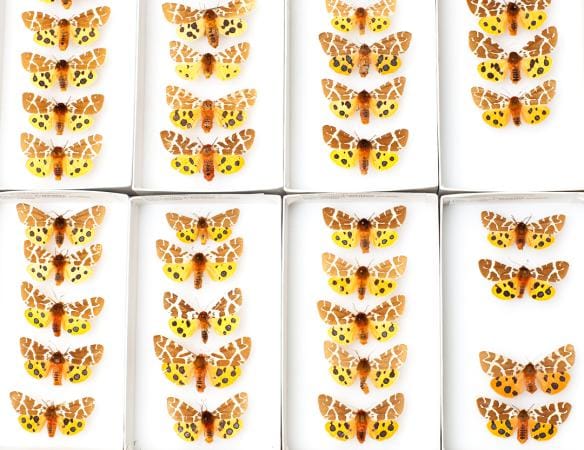
Researchers are welcome to examine the collections by contacting the appropriate curator and making arrangements with the collections manager. Please give as much notice as possible. You may contact museum staff by e-mail, letter, or phone. We will want to know the expected dates of your visit, the specimens you want to examine, and your equipment needs (e.g., a microscope). Collection access is between 9:00 AM to 4:30 PM, Monday to Friday, unless otherwise arranged with the curator or collection manager. Requests for loans of specimens must go through the collection manager.